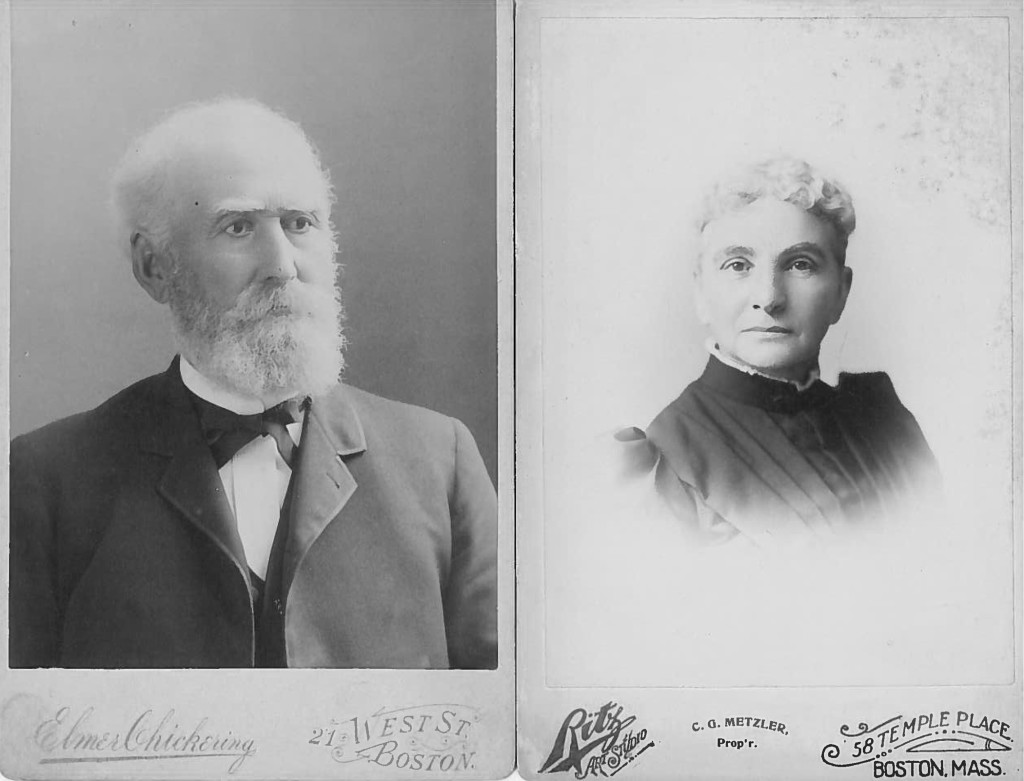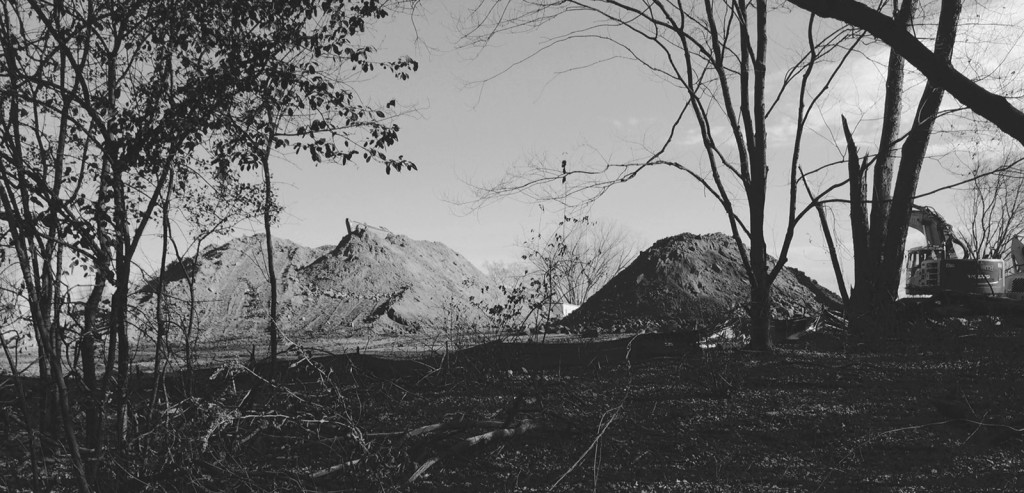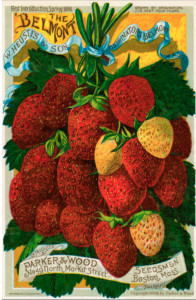
By Anne-Marie Lambert
This article is the second in a series of articles about the history of the Belmont Uplands. For Part 1, see “Uplands Area Transformed Over Centuries” in the September/October 2014 Belmont Citizens Forum Newsletter.
We don’t know how exactly how Warren Heustis of Putney, Vermont met Lucy Ann Hill of West Cambridge (now Belmont). We do know they married in 1845, and that Warren brought farming skills to Belmont that would turn “useless swamp land” into one of the best performing farms in Belmont, the Heustis Farm. This is their story.
Today it is hard to imagine the Hill Farm where Lucy grew up. It is hard to imagine Belmont, not yet incorporated, without a railroad, without any asphalt or suburban homes, without today’s Route 2, and without Acorn Park Drive. A trip to Belmont’s one remaining farm, Belmont Acres on Glenn Road, is the best way to visualize what is now Belmont in the mid-1800s.
Hill Family and Railroad Ties
Lucy and her two colorful brothers, Henry Y. Hill and Amos Hill Jr., were descendants of a land-owning family that had lived in Massachusetts since the 1600s.
Hill Road ran entirely through Hill family property and led to what is now known as the Belmont Uplands. It started at the main road farmers used to bring goods to Brighton, on Brighton Street, the same place where a shorter Hill Road begins today. It then continued with the Hill Road bridge over Pickerel Brook (now Little River), and on to the future Heustis Farm (now the Belmont Uplands). The decaying bridge piers are still visible from Little River. The spring alewife herring run to Little Pond and Spy Pond must have been dramatic, and it must have been interesting to watch the nascent ice industry must emerge at the Hittinger ice house next door on Little Pond. A major heron rookery still existed at the present-day Alewife T stop, with a marsh on three sides and two clay pits nearby (today’s Yates Pond and Jerry’s Pond.) A maple swamp still existed where the Fresh Pond shopping center is today.
As a young adult, Lucy witnessed the building of the “Ice Railroad” from Boston Harbor to Fresh Pond, Waverley, and other stops on the way to Fitchburg. The negotiation of a railroad flag stop at “Hill’s Crossing” must have kept family conversations lively. When Amos Hill Sr., decided to give Lucy and her new husband 13 acres behind her brothers’ properties, was he anticipating the key role the railroad would play in their future? Did he foresee the 1852 negotiation of a Heustis Farm railroad sub-spur off the Spy Pond Ice spur, which was itself a spur of the Lexington and West Cambridge Railroad ?
Soil and Water
Warren and Lucy Heustis did not have to worry much about irrigation; their land was surrounded by Little Pond, Pickerel Brook, and the Great Marsh. Through photographs and the 1880 tax record, we know there was a windmill drawing water to the fields, likely from Perch Pond along the Pickerel Brook. The ancient marsh would have ensured the soil was rich in nutrients. However, with all the clay pits nearby, they must have worried about drainage. In fact, we have learned from recent excavations for the foundations of the “Residences at Acorn Park” at the Belmont Uplands that under the first foot or so of soil their farm was sitting atop a giant mound of beach-quality sand, one of the best drainage spots in the area.
The presence of this glacial kame was a surprise given the data from 2010 soil borings, but helps explain how Heustis Farm thrived for 100 years. For more information about the soil borings, see “Uplands Geology Makes Development Difficult,” Belmont Citizens Forum Newsletter, November/December 2013.
Pigs, Strawberries, Celery, and More
Amos Hill Sr. soon extended his daughter and son-in-law’s 13 acres to 24. Warren used the land to grow award-winning strawberries, an orchard, and vegetables. He was a very active member of the Massachusetts Horticultural Society from 1858 onwards, and other Belmont farmers joined as well, including Elisha Atkins (1854), brother-in-law Henry Y. Hill (1860), and Varnum Frost (1864). Heustis won strawberry prizes for his “Colonel Cheney” strawberries in 1875, and a special prize for “four quarts of the finest berries in form, color and quality” for his “Belmont” strawberries in 1873. He and his son also won awards for their celery, cabbages, spinach, lettuce, turnip-rooted beets, green-flesh melons, and other fruits and vegetables, and exhibited “forced specimens of cucumbers, lettuce, radishes, dandelions and tomatoes” downtown. Heustis later imported short-nosed Yorkshire pigs to establish what became known as the “largest fancy pig farm in this part of the country.”
Meanwhile, the Heustis family at 85 Hill Road in West Cambridge (now Arlington) slowly expanded. Their first child, Freddie, only lived to be three years old (1847-1849). Their daughter L. Malvina arrived in 1851, just as the 10-year debate over incorporating Belmont was getting started. A second daughter, Eveline, arrived around 1858.
The year 1859 must have been especially busy, with the birth of son W. Howard, and preparations for the first annual strawberry festival to mark Belmont’s founding year. Belmont’s first borders extended to include what is now Acorn Park Drive and Alewife Reservation as well as half of Fresh Pond. Soon afterwards, the town’s Underwood family played a key role in developing canning techniques to feed Union soldiers during the War Between the States (1861-1865). Were Heustis vegetables or pigs inside those cans?
In 1873, Heustis & Son went to Madison Square Garden in New York City with their pigs, coming home with awards for “Swine, small white breeds”; first place for the boars “Dandy” and “Hilton,” second and third place for the sows “Mary Belmont” and “Belle Bilton.”
Water Pollution Troubles
The farm may have been affected by a combination of actions which aggravated the barrier effect of railroad embankments that had been built for the spur line. These blockages created a stagnant swamp where there used to be a flowing wetlands. In 1873, Cambridge blocked tidal flow from Alewife Brook at Fresh Pond.
In 1875, Cambridge built a brick aqueduct right next to the farm to carry water from Little Pond all the way to Fresh Pond without touching the swamp itself. In 1876, the Heustis family may have joined Arlington celery farmers in objecting to the change in irrigation flows from the installation of tidal gates on Alewife Brook at Broadway and to a dam where Wellington Brook then flowed into Alewife (near today’s Minuteman Bikeway along the Alewife T station). The water traveling from Alewife Brook and Wellington Brook into hay field irrigation ditches made up some of the last cleansing flows of the Great Marsh. The annual expense of dredging the hay fields was justified by sales to the ice industry, which needed the hay for insulation.
Pollution concerns came to a head in 1880, with a successful Petition from the Mayor of Cambridge to Re-Annex Portions of Belmont. Pollution sources included horse manure and tanneries and slaughter houses and human sewage going into Alewife Brook, which passed through the swamp. The mayor’s petition was triggered by a slaughterhouse near Fresh Pond, recently authorized by the Belmont board of selectmen. Being a loyal Belmont citizen, I suspect it was a pretext for a plan they had in mind anyway and were just looking for the next excuse to change the border. There was also a slaughterhouse near what is now the site of the Alewife T station in Cambridge dumping into Alewife Brook, which Cambridge’s mayor didn’t seem to regulate very tightly.
When the Heustis’s son Howard married Belle Lancaster of Portland, Maine, in 1881, the Heustis Farm was still in Belmont, barely. Thanks to the Petition from the Mayor, their hay-farming neighbors along today’s Acorn Park Drive and Alewife Reservation had become residents of Cambridge. By then their daughter Malvina had married Jeff Skillings, a Winchester lumber dealer.
Heustis Farm Carries On
In June of 1884, the Massachusetts Horticultural Society took an excursion to visit the ground of W. Heustis & Son, with particular interest in their new breed of late-blooming strawberry, the “Belmont.” “Belmont” berries were very large and ripened much later than other strawberries. It was one of the few varieties available in Boston markets in July. Agricultural issues of the day included the use of chemical fertilizers and pesticides, as well as canning technology to handle an over-supply of tomatoes.
When Warren Heustis Sr. died in 1890 at the age of 72, he had met his first two grandchildren, knew the farm was thriving under his son’s care, and was eulogized as a “lover of the rose and an esteemed member of the vegetable committee” of the Massachusetts Horticultural Society. Lucy died in 1896 at the age of 75, having met two more grandchildren. They were both buried at Mount Pleasant Street cemetery in Arlington beneath a Heustis family monument decorated with engravings of strawberries and roses.
Anne-Marie Lambert is a director of the Belmont Citizens Forum.





Sorry, the comment form is closed at this time.